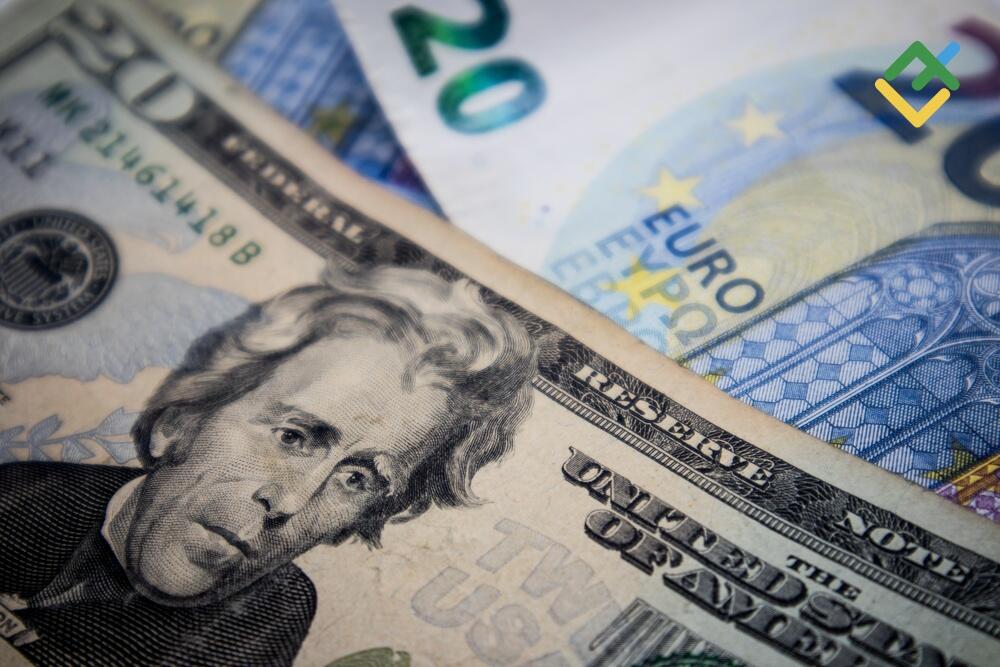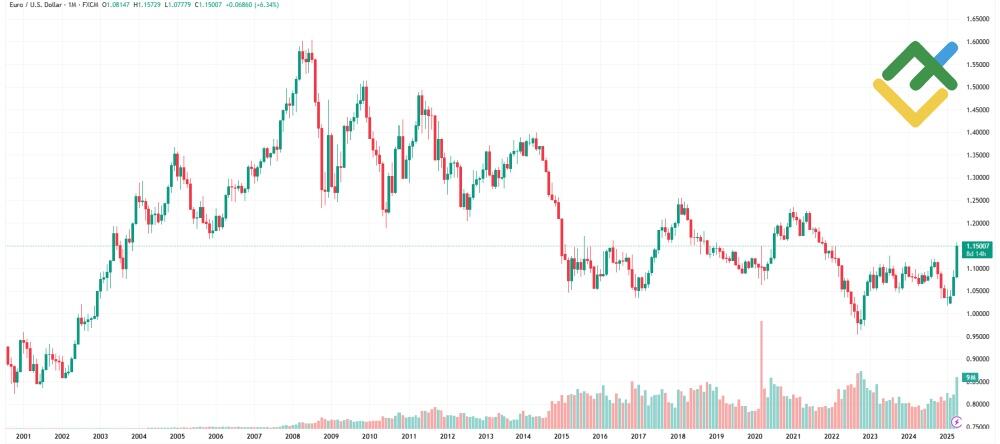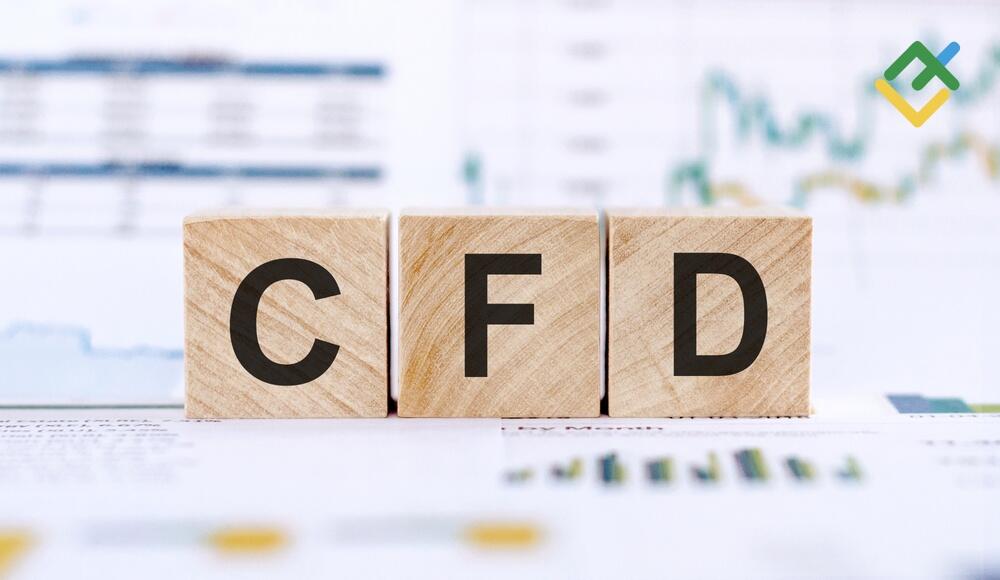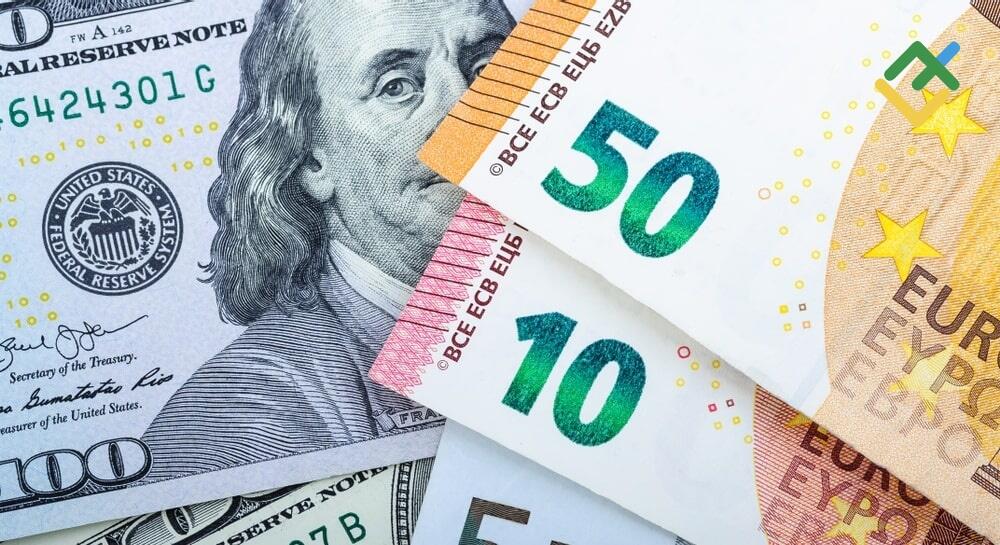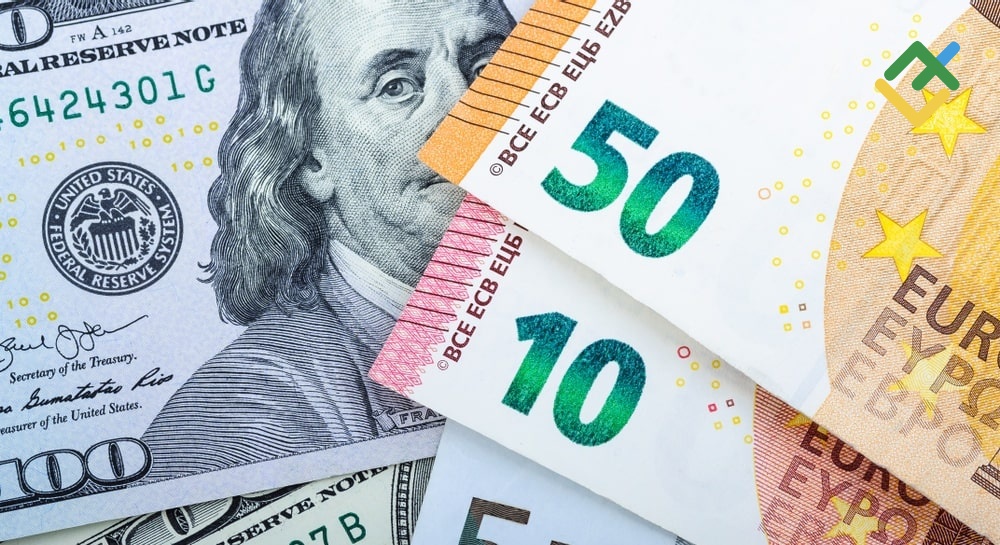
The euro/dollar (EURUSD) currency pair is among the most traded pairs in the Forex market, favored for its high liquidity, narrow spreads, and substantial trading volumes. Its popularity stems from the strong interest of both institutional and retail traders, making it an appealing choice for beginners and seasoned market participants.
Traders, regardless of their experience, should grasp the unique traits of the EURUSD pair to capitalize on its trading potential. This article outlines effective strategies for the euro-dollar trading and explores why this pair is considered one of the most stable in the market.
Major Takeaways
- EURUSD is the most traded currency pair on Forex, accounting for almost a quarter of all transactions.
- The EURUSD exchange rate depends on the monetary policy of the US Fed and the European Central Bank.
- The main factors affecting the EURUSD exchange rate include GDP growth rates, the inflation level, retail sales, and interest rates.
- The EURUSD pair is highly liquid and volatile, which makes it commonly chosen by traders.
- When trading the EURUSD pair, technical and fundamental analyses are employed, examining indicator readings alongside macroeconomic data.
- The best time for day trading is during the overlap between the London and New York sessions.
- Geopolitical events may significantly affect the EURUSD price.
- A trading platform that offers a demo account is the ideal way to learn how to trade the EURUSD pair safely.
EURUSD Pair Overview
The US dollar, embodying the world’s largest economy, and the euro, the unified currency of the European Union, constitute one of the most influential currency pairs in global finance. In this pair, the euro is the base currency, and the US dollar is the quote currency. The EURUSD pair serves as a vital conduit for international trade and cross-border investment, with its valuation intricately tied to the political stability and economic trajectories of both the US and the Eurozone.
The history of the US dollar dates back to 1776, when it was adopted as the national currency following the country’s declaration of independence. Its global influence surged after World War II, as the weakened British economy left the pound unable to compete on equal terms. Meanwhile, Europe had long nurtured the ambition of creating a unified currency, which ultimately materialized in 1999 with the launch of the euro, the single currency for 19 Eurozone member states.
Since its inception, the EURUSD pair has evolved into the most actively traded currency pair in the world, influencing numerous cross rates such as EURJPY and GBPUSD. Therefore, traders need to monitor not only technical indicators but also global economic news and the monetary policies of major central banks.
EURUSD Pair Performance in 1999–2025
The EURUSD pair is characterised by constant fluctuations. While it initially traded below parity following its introduction, it has mostly remained above the $1 mark since autumn 2002.
The EURUSD pair reached its all-time high of $1.6039 on 15.07.2008. The all-time low was recorded on 26.10.2000 when the pair declined to $0.8227.
Following the 2008 financial crisis, the exchange rate stood at $1.23. The economic landscape shifted dramatically during the COVID-19 pandemic, leading to sharp spikes in liquidity. In 2021, the exchange rate ranged between $1.17 and $1.23, highlighting the tensions surrounding the Federal Reserve’s monetary policy during that period.
In 2022, the euro dropped below parity with the dollar for the first time in quite a while, amid aggressive Fed rate hikes and the economic crisis in the EU. However, in 2023, the EURUSD pair stabilised in the $1.05–$1.10 range.
As of the first half of 2025, the EURUSD pair is trading in the range of $1.02–$1.15 due to global market uncertainty and a challenging geopolitical environment.
Reviewing the pair’s historical performance provides valuable insight into its cyclical nature and overall stability, helping make more informed forecasts about future movements. Notably, the EURUSD pair reacts not only to economic conditions in the US and EU but to broader global risks as well.
Latest EURUSD Trend Changes
In 2025, the EURUSD pair has shown significant volatility, with exchange rates ranging from $1.02 to $1.15. This fluctuation results from various factors, including the monetary policies of the Federal Reserve and the European Central Bank, macroeconomic reports, and global geopolitical tensions. Changes in interest rates by central banks trigger immediate responses in the Forex market.
Key economic data, such as retail sales and gross domestic product (GDP), also remain significant factors. These indicators affect investor sentiment and the price of the pair.
Factors Affecting the EURUSD Currency Pair
The EURUSD exchange rate depends on a variety of macro- and microeconomic factors:
- Monetary policy decisions. Quantitative easing, programs tapering, or introducing new stimulus measures tend to immediately impact the exchange rate. The interest rate differential between the US and the EU also influences the EURUSD pair.
- Key economic data. Consumer prices, retail sales, unemployment rate, and GDP may affect central banks’ decisions on future interest rates.
- Geopolitical events. Instability in Europe or the US, elections, military and trade conflicts, or sanctions may temporarily increase the volatility of the traded currency pair.
- Overall state of financial markets. Investors’ risk appetite (risk-on/risk-off) affects the attractiveness of foreign currencies, including the euro dollar pair.
Analysing these factors requires a systematic approach, allowing traders to make more informed decisions in both short-term and long-term trading.
Best Time to Day Trade EURUSD
Choosing the right time for trading is vital, particularly in day trading. The EURUSD pair sees its highest trading volumes during the overlap of the European and American sessions, from 15:00 to 18:00 GMT+3. During this period, major exchanges—London and New York—are open, leading to favorable conditions for significant price movements, especially with key economic data releases or central bank announcements.
Additionally, traders should monitor macroeconomic statistics. Reports on retail sales, GDP, consumer prices, and interest rate decisions are typically released at 15:30 and 17:00 GMT+3, often causing sharp price movements of 30–100 pips within minutes.
A trading day can be divided into periods of high and low volatility:
- Asian session (02:00–10:00, GMT+3): low activity on the EURUSD pair.
- European session (10:00–18:00, GMT+3): increased liquidity and trend formation.
- American session (15:00–23:00, GMT+3): highest volatility.
- Evening (after 18:00 GMT): lower activity, possible sideways movement.
Understanding these regularities allows traders to develop strategies based on specific periods of the day and to follow risk management rules, such as avoiding trading when unexpected news is released.
EURUSD Technical Analysis
Technical analysis is an essential part of Forex trading. When applied to the EURUSD pair trading, it helps identify potential entry and exit points based on historical price movements. The main tools include technical indicators and chart patterns.
Popular Technical Tools
- Moving averages (MA) determine the prevailing trend and its strength.
- The MACD indicator assists in identifying trend reversals or continuations.
- The RSI (Relative Strength Index) signals when the market is in an overbought or oversold condition.
- Support and resistance levels are key zones where prices tend to reverse.
- Fibonacci retracement levels help assess potential corrections after a strong price movement.
Practical Application Examples
- A bullish crossover of the 50-period and 200-period MAs can signal an opportunity to open long trades.
- If the RSI value exceeds 70, consider locking in profits on long trades.
- The key levels of 1.1000, 1.1200, and 1.1500 are significant psychological thresholds often used by experienced market participants in their trading systems.
Conclusion: Technical analysis plays a vital role in both short-term and long-term strategies. Besides, its effectiveness increases significantly when it’s combined with fundamental analysis and solid risk management practices.
EURUSD Trading Strategies
A trading strategy is a systematic approach to opening trades based on market conditions and fundamental and technical analyses. There are many approaches to trading the EURUSD pair, as it is one of the most traded currency pairs.
1. Trend Trading
Trend trading is a strategy involving identifying a directional price movement. A trader determines the upward or downward trend using technical indicators and then opens positions in the trend’s direction.
Example: If the EURUSD pair breaks through the resistance level amid the release of a strong Eurozone GDP report, one may consider long trades. The MACD and moving averages can be used to confirm the trend.
2. Scalping
Scalping is a fast-paced intraday trading strategy in which traders open multiple positions within short-term time frames, from a few seconds to several minutes. This approach demands quick decision-making, a stable internet connection, and a high-quality trading platform.
Advantages: High trade frequency and the opportunity to generate steady profits.
Risks: High sensitivity to spreads and commissions, cognitive strain from constant focus.
3. Swing Trading
Swing trading is a medium-term strategy that involves holding positions open for several hours or days. It is based on a combination of technical and fundamental analysis.
Tools: RSI, support/resistance levels, candlestick patterns.
4. News Trading
News trading is suitable for those who closely follow the publication of key economic data. During the release of retail sales reports, consumer price data, or the publication of US Fed decisions, sharp price jumps are observed, creating attractive trading opportunities.
Tip: In news trading, it is crucial to set stop-loss and take-profit orders in advance to minimise risks.
5. Automated Trading
Automated trading involves using expert advisors or robots customized for a specific trading system. This approach is especially relevant for the EURUSD pair due to its high liquidity and relative predictability.
Important: Test your strategy on a demo account and follow the risk management rules.
Every strategy requires discipline, skill, and analysis. Beginners are advised to start with swing trading or trend trading and then, as they build their experience, they can venture into other strategies.
Get access to a demo account on an easy-to-use Forex platform without registration
Fundamental Analysis of Upcoming Economic and Political Events
Fundamental analysis is vital for forecasting long-term currency movements, especially concerning the EURUSD pair. This approach relies on examining key economic data, monetary policies, and the global political landscape. Traders who adopt a fundamental approach pay close attention not just to the current market conditions but also to anticipated shifts in the economy.
Key Aspects of Fundamental Analysis
- Monetary policy. The US Federal Reserve (Fed) and the European Central Bank (ECB) influence exchange rates by adjusting interest rates and applying either stimulus or tightening measures. For example, if the Fed adopts a more aggressive policy stance while the ECB remains dovish, the US dollar may strengthen against the euro.
- Macroeconomic indicators. Gross domestic product (GDP), retail sales, consumer prices, and unemployment rates are indicators of economic stability. Regular analysis of this data helps predict central banks’ decisions.
- Political and geopolitical events. Elections, crises, trade wars, and sanctions directly affect foreign currencies. For example, tensions between the EU and the US can lead to high volatility in the euro-dollar exchange rate.
- Comparative analysis of major economies. The EURUSD pair reflects the relationship between the US and the EU. Therefore, it is important to take into account their relative strength, stability, and growth prospects.
- The economic calendar allows you to track news release dates and build long-term trading strategies.
Fundamental analysis is particularly useful in developing medium- and long-term trading strategies. When combined with technical analysis, it helps pinpoint the best moments to open or close trades more effectively.
Contract for Difference (CFD) Trading
A Contract for Difference (CFD) is a derivative instrument that allows you to trade the EURUSD pair without owning the actual currencies. Instead, you make an agreement with your broker to exchange the difference between the opening and closing prices of a position. This makes CFDs a flexible way to trade the world’s most actively traded currency pair.
EURUSD CFD Trading
- Access to leverage. CFDs enable you to open trades that significantly exceed your actual deposit, increasing both your potential profits and risks.
- Ability to open long and short trades. Unlike traditional trading, CFDs make it possible to profit from rising and falling currency pairs.
- Instant trade execution and flexible conditions. Most brokers offer quick trade execution via a user-friendly trading platform, which is especially important for day trading.
- Low fees and commissions. CFD trading often comes with minimal spreads, especially for highly liquid assets like the EURUSD pair.
Features and Risks
- Proper risk management is essential when trading with leverage. This includes setting stop-loss orders, controlling position sizes, and allocating capital wisely.
- Since these transactions do not involve the physical delivery of assets, it is essential to select a reliable broker regulated by a reputable financial authority.
- CFDs may not be accessible in some jurisdictions, so you should get to know the legal aspects beforehand.
Trading the EURUSD pair with CFDs is perfect for both novice and professional traders. Moreover, it is an effective way to use a trading system based on price movement analysis, economic reports, and central bank decisions.
EURUSD Trading Tips
Before diving into trading the EURUSD pair, it is essential not just to select a strategy but also to cultivate habits that will help you stay disciplined and adjust to the ever-changing conditions of the financial markets.
Practical Guidance
- Start with a demo account to test your trading strategy without any financial risk. This is especially important for beginners and for learning the features of a trading platform.
- Stay updated on the economic calendar. Track key economic data such as GDP, retail sales, and consumer prices on a regular basis to gauge market expectations and adjust your trading decisions.
- Mitigate your risks effectively. Never risk more than 1–2% of your deposit for a single trade. Always use stop-loss orders and be mindful of your risk-reward ratio.
- Combine fundamental and technical analysis. This approach will enhance your ability to identify optimal entry and exit points, particularly when trading ahead of significant news releases, including central banks’ announcements.
- Pay attention to timing and liquidity. It is better to trade during periods of maximum activity when the European and American sessions intersect. Avoid trading during periods of low volatility, especially if you prefer trend-following strategies.
- Keep a trading journal. Log each trade along with your reasoning, outcome, and emotions. This habit can help identify your weaknesses and improve your trading skills.
- Keep up with the news and geopolitics. Even the best strategy may not work when news related to the euro-dollar exchange rate or global instability breaks out.
Conclusion
EURUSD is not just a tradable currency pair but a powerful tool that reflects the economic and political interdependence of two major economies: the US and the Eurozone. The asset’s liquidity, accessibility, and predictability make it the top choice for most traders in the Forex market.
The following factors are essential for successful trading:
- Understanding of fundamental analysis, including the monetary policies of the US Federal Reserve and the European Central Bank;
- Technical analysis skills;
- Adherence to risk management principles;
- Access to a reliable trading platform and regular testing of strategies on a demo account;
- Constant development and adjustment of your trading strategy.
Remember: trading the EURUSD pair successfully, even in highly volatile conditions, requires effective use of a trading system, a solid understanding of how currency prices are formed, and the ability to analyze economic data.
EURUSD Trading FAQs
The EURUSD pair can be traded around the clock from Monday to Friday. However, the highest activity is observed during the overlap of the European and American trading sessions, from 15:00 to 18:00 GMT+3.
The EURUSD exchange rate depends on many factors, including interest rates, economic data, central bank decisions, and geopolitics. Although it is impossible to make accurate predictions, analysing these factors can help identify a potential trajectory.
You can invest in the EUR USD foreign exchange pair via the LiteFinance broker using a unique online platform. It is important to choose a strategy, assess risks, and monitor fundamental and technical market signals.
The euro may appreciate in 2025 if buoyed by robust economic figures data from the Eurozone and a dovish US Fed’s stance. Key factors such as inflation rates, GDP growth, and decisions made by the European Central Bank will significantly influence the pair.
In 2026, the euro price will depend on interest rate differentials, central bank policies, and global economic trends. Under favourable conditions, the euro may strengthen against the US dollar.
The US dollar remains one of the most stable currencies in the world. It is widely used as a reserve currency and a safe-haven asset, especially during economic instability and crises. However, before making investment decisions, carefully examine economic and geopolitical news.
Selling the EURUSD pair means you expect the exchange rate to fall. In other words, you are selling euros and buying US dollars, hoping to buy back the euros later at a lower price to make a profit.
Using popular indicators such as the RSI, MACD, and moving averages is advisable. These tools help quickly assess trend direction and spot entry points on lower time frames.
Price chart of EURUSD in real time mode
The content of this article reflects the author’s opinion and does not necessarily reflect the official position of LiteFinance broker. The material published on this page is provided for informational purposes only and should not be considered as the provision of investment advice for the purposes of Directive 2014/65/EU.
According to copyright law, this article is considered intellectual property, which includes a prohibition on copying and distributing it without consent.
{{value}} ( {{count}} {{title}} )
This post is originally published on LITEFINANCE.

